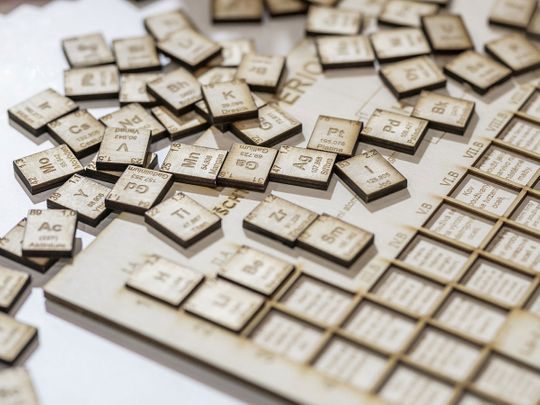
Take a close look at the periodic table… does it resemble a game of cards? Solitaire, perhaps?
Click start to play the Weekend Crossword, where you can identify various elements from the periodic table.
You wouldn’t be mistaken if you said it does resemble Solitaire. There is a good reason why. The modern periodic table was invented by Russian chemist Dmitri Mendeleyev, who presented it on March 6, 1869, at the Russian Chemical Society. Mendeleyev was very fond of card games – it’s why he wrote the weight of each element on a separate index card, and displayed them as you would in a game of Solitaire. Elements with similar properties formed a ‘suit’ – they were then placed in columns, organised in a hierarchy of ascending atomic weight.
Sadly, the periodic table often conjures up moments in our past when we would have had to tediously memorise the elements. But this inspired table has served as a map for students of chemistry, and scientists, all around the world.
It even served as an accurate predictor for elements that had not yet been discovered.
When Mendeleyev created the original table, there were several blank spaces in it, since he was aware of 63 elements at the time (out of the current 118). But by estimating the properties of these elements in relation to the ones right next to them, Mendeleyev was able to correctly predict future discoveries. For instance, he estimated the weights and chemical behaviours of gallium, scandium and germanium before those elements were discovered.
Another ingenious aspect of the periodic table is that its symmetry has a practical function. If you take cut out the complicated middle columns of the periodic table and fold it once along the middle of the Group 4 elements, the groups that ‘kiss’ are the ones that can be fused together in a stable manner. Their complementary electron structures allow for the seamless combination. Wish you knew this hack in school?
While the periodic table currently has 118 elements, the International Union of Pure and Applied Chemistry (IUPAC) is tasked with the responsibility of maintaining and updating it. In 2016, they approved the name and symbols for the last four elements added to the table – nihonium (Nh), moscovium (Mc), tennessine (Ts) and organesson (Og).
Naming depends on several factors – sometimes, the elements are named after famous scientists (like Einsteinium) and in other cases, they are named after placed where they were discovered (like germanium and americium), or the Greek word that best describes them (bromine is from the Greek word bromos, meaning ‘stench’, because of its terrible smell). Mythology also inspires element naming conventions – for instance, thorium is named after Thor, the Norse deity of thunder.
Full of science and history, there’s more to the periodic table than meets the eye.
Did you know these interesting facts about the periodic table? Play the Weekend Crossword and tell us at games@gulfnews.com.



